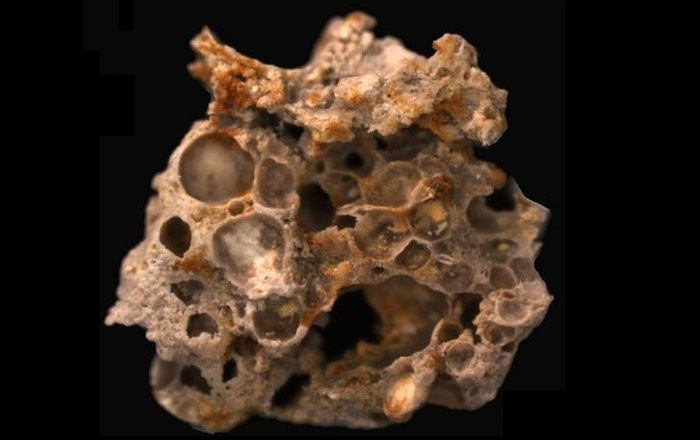Found oxygen stored by bacteria in fossil samples 1.6 billion years ago
According to Geobiology magazine, Swedish and Danish paleontologists analyzed the 1.6-billion-year-old fossils, found in central India. They found that there were tiny globular cavities created by oxygen bubbles.

Stone form formed by bacterial membranes and air bubbles in it - (Photo: Stefan Bengtson).
There are very few traces of bacterial species that lived millions of years ago. Those traces are the structures of cyanobacteria , stone patterns formed by bacterial membranes and air bubbles in them. Bacteria that leave traces in the form of oxygen bubbles are the first life forms on Earth , making them suitable for the appearance of plants and animals.
Those cyanobacteria that live in shallow waters may have left those air bubbles. They produce oxygen by photosynthesis and sometimes "stuck" in the sticky membrane of the sticky bacteria in the form of bubbles. The membranes between some bubbles are twisted deformed, which makes the material contain resilient air bubbles.
Fossilized cyanobacteria membranes are stored in stromatolite strata, found at the bottom of shallow waters. Protozoan and multicellular algae may all have been involved in the formation of different fossilized cyanobacteria plaques.
- Detection of 2.5-billion-year-old fossil microbes live without oxygen
- The first sign of life on Earth could be bacteria
- Bacteria more than three billion years old hide in the cave
- Found bacteria can make oxygen to respire
- The oldest fossil on Earth
- Burning too much fossil fuel, humans are eroding Earth's oxygen source
- Most creatures on Earth disappeared 2 billion years ago
- The oldest wood fossil
- The oldest fossil on Earth
- 'Fossil' 3.7 billion years old is once again shocking because it seems to be just normal stone
- Oxygen gas exists when humans have not yet appeared
- Discovering fossil mushrooms about a billion years old
 Discovered an ancient centipede fossil 99 million years old
Discovered an ancient centipede fossil 99 million years old Discovered bat-like dinosaurs in China
Discovered bat-like dinosaurs in China Discovered a 200-year-old bronze cannon of the coast
Discovered a 200-year-old bronze cannon of the coast Discover 305 million-year-old spider fossils
Discover 305 million-year-old spider fossils The mystery of 'frozen' bubbles at Lake Abraham
The mystery of 'frozen' bubbles at Lake Abraham  The 'bubble raft' solution can help the Earth cool down
The 'bubble raft' solution can help the Earth cool down  What are opaque foam that appears in the food pot when cooking?
What are opaque foam that appears in the food pot when cooking?  Why can soap bubbles explode?
Why can soap bubbles explode?  Explain the phenomenon of foaming beer when smashed into the mouth of the bottle
Explain the phenomenon of foaming beer when smashed into the mouth of the bottle  7,000 air bombs can create giant pits in Siberia
7,000 air bombs can create giant pits in Siberia 